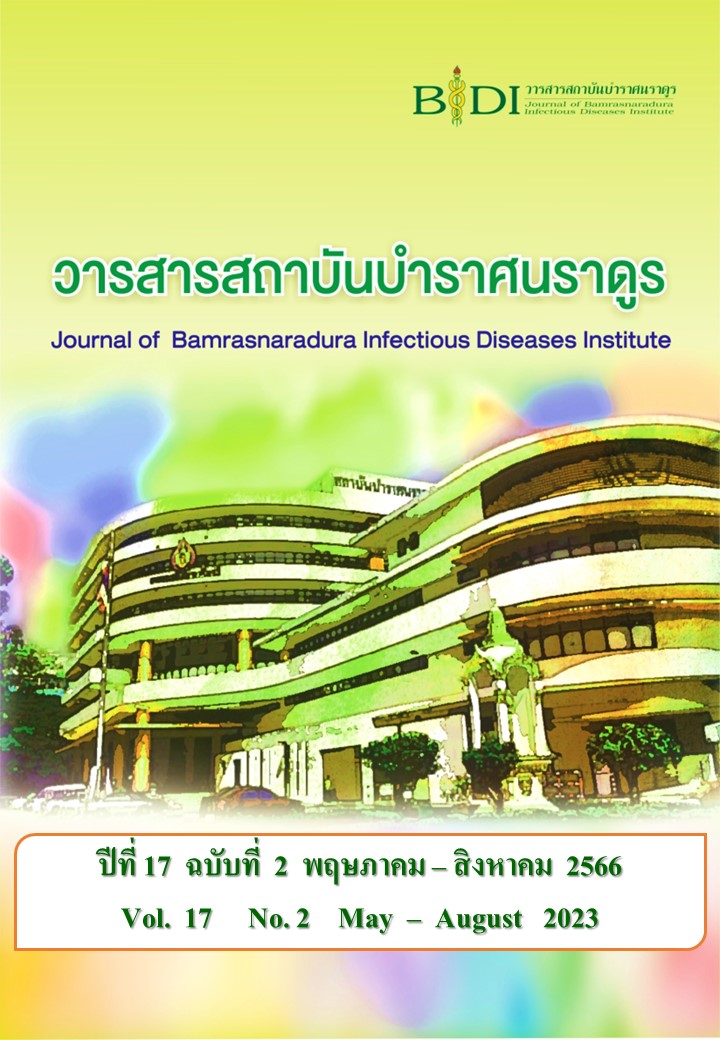Development of Carbohydrate Counting Education Model Using by Local Learning Media for Diabetes Mellitus Patients in Phonphang Subdistrict Municipality, Sakon Nakhon Province
Main Article Content
Abstract
This study was a quasi experimental research. The purposes were to development of carbohydrate counting model using local learning media for diabetic patients in Phon Phang Sub-district Municipality, Akat Amnuai District, Sakon Nakhon Province. The research is divided into 3 steps: Step 1; study of situations, state of problems, and the needs for developing carbohydrate counting models using local learning media for diabetic patients. Step 2; develop the carbohydrate counting model using local learning media for diabetic patients. Step 3; study the effectiveness of carbohydrate counting model using local learning media for diabetic patients about the knowledge of carbohydrates, eating habits and blood glucose levels by collecting data before and after the experiment, the one-group pretest-posttest design consists of 39 participants in joining the project during 8 weeks, compare the differences before and after the test using paired sample T-Test. The confidence level is at 0.05.
The results showed that the carbohydrate counting model using local learning media for diabetic patients consisted of 1) knowledge creation system 2) important mechanism for driving the system, after the model was tested, it was found that knowledge about carbohydrates was increased (p < 0.001), the overall of food habits were significantly improved at (p<0.001) with the behavior of 1) measuring or measuring rice before eating, 2) a void of eating fruit until satiety, 3) counting the carbohydrate units in each meal. 4) limiting the amount of starchy food 5) drinking alcohol clearly improved and the blood sugar level decreased significantly at (p=0.013) and the subjects were satisfied with the study model at a high level ( = 4.5, SD =0.6). From the result, it can be a good guideline for health care of diabetic patients.
Article Details
References
Srivanichakorn S. Morbidity and mortality situation of non-communicable diseases (diabetes type 2 and cardiovascular diseases) in Thailand during 2010-2014. Disease Control Journal 2017; 43(4): 379-390. (in Thai).
Division of Noncommunicable Diseases. Number and rate of patients in NCDs 2015 [Internet]. 2015 [cited 2017 Aug 23]. Available from: http://thaincd.com/2016/mission/documents.php?tid =32&gid=1-020 (in Thai)
Sakon Nakhon Provincial Health Office. Chronic NCDs Report 2010 – 2014 [internet]. 2014 [cited 2020 November 25]. Available from: https://www.skko.moph.go.th/dward/document_file/ncd/ncd_stat_link/20140127170225_964532898.rar
Aekplakorn W, Chariyalertsak S, Kessomboon P, Assanangkornchai S, Taneepanichskul S, Putwatana P. Prevalence of diabetes and relationship with socioeconomic status in the thai population: national health examination survey, 2004–2014. J Diabetes Res 2018 Mar 1; 2018(1654530): 1-8. Doi: 10.1155/2018/1654530.
Norabin N, Chanpen U, Sowat C. The experience in controlling blood sugar levels for type 2diabetic patients. Journal of Preventive Medicine Association of Thailand 2020; 10(2): 351-365. (in Thai)
Ronghanam S. The development of a holistic nursing service system for diabetic patients receiving diabetes care at mahasarakham hospital. Journal of Nurses’ Association of Thailand, North-Eastern Division 2009; 27(3): 22-30. (in Thai)
Wattanakorn K, Deenan A. Developing the eating behavioral modification program for obese diabetics. Journal of Psychiatric Nursing and Mental Health 2013; 27(2): 143-155. (in Thai)
Kasikun R, Muktabhant B. Assessment of carbohydrate counting counseling in the Type 2 diabetic patients. Srinagarind Med J 2013; 28(4): 442-450. (in Thai)
Dzed L. Development of nutrition educational tool for diabetic patients in Bhutan based on the basic level of carbohydrate counting concept [dissertation]. Bangkok: Mahidol University; 2009. (in Thai)
Zipp C, Roehr J T, Weiss L B, Filipetto F. Impact of intensive nutritional education with carbohydrate counting on diabetes control in type 2 diabetic patients. Journal of Patient Preference and Adherence 2010 Dec 30 ; 5: 7–12. doi: 10.2147/PPA.S13907. PMID: 21311697
Ewers B, Bruun JM, Vilsbøll T. Effects of basic carbohydrate counting versus standard outpatient nutritional education (The BCC Study): study protocol for a randomised, parallel open-label, intervention study focusing on HbA1c and glucose variability in patients with type 2 diabetes. BMJ Open 2019 Nov 21; 9(11): e032893. doi: 10.1136/bmjopen-2019-032893.
Martins MR, Ambrosio AC, Nery M, Aquino RD, Queiroz MS. Assessment guidance of carbohydrate counting method in patients with type 2 diabetes mellitus. Prim Care Diabetes 2013 May 20; 8(1): 39-42. Doi: 10.1016/j.pcd.2013.04.009.
Chaiyakhot J, Somwang S, Hathaidechadusadee A, Areevut C, Saetung S, Saibuathong N, et al. Effects of Carbohydrate Counting on Glycemic Control in Type 1 Diabetes Patients: Clinical Experience in Thailand. J Med Assoc Thai 2017; 100(8): 856-63. (in Thai)
Lopes Souto D, Lopes Rosado E. Use of carb counting in the dietary treatment of diabetes mellitus. Nutr Hosp 2010; 25(1): 18-25.
Wibunrattanasri N. Development of the self-help guidelines for meal planning using carbohydrate counting for diabetes care [dissertation]. Bangkok: Mahidol University; 2002. (in Thai)


